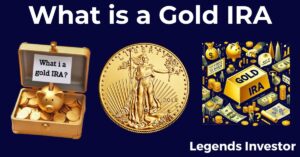Understanding Investment Options in an IRA: The Role of Gold
Investing for retirement is a crucial aspect of financial planning, and Individual Retirement Accounts (IRAs) offer a variety of options to build a diversified and robust portfolio. Among these options, gold stands out as a unique asset that has been valued for millennia. This article explores the role of gold in an IRA, comparing it to other common investment options and examining its potential benefits and risks.
Explaining Individual Retirement Accounts (IRAs) and Their Purpose
Individual Retirement Accounts (IRAs) are tax-advantaged accounts designed to help individuals save for retirement. There are several types of IRAs, including Traditional IRAs, Roth IRAs, SEP IRAs, and SIMPLE IRAs, each with its own rules and benefits. The primary purpose of an IRA is to encourage long-term savings by offering tax advantages.
Variety of Assets Available in an IRA
An IRA can hold a wide range of assets, allowing investors to build a diversified portfolio. Common assets include:
- Stocks: Shares of individual companies.
- Bonds: Debt securities issued by corporations or governments.
- ETFs (Exchange-Traded Funds): Funds that track indexes and trade like stocks.
- Mutual Funds: Pooled funds managed by professional managers.
- Precious Metals: Physical assets like gold, silver, platinum, and palladium.
Introduction to Gold as a Potential Investment Within an IRA
Gold is a popular investment within IRAs due to its historical reputation as a store of value and hedge against inflation. Gold IRAs allow investors to include physical gold, gold ETFs, and gold mutual funds in their retirement accounts, offering a unique opportunity to diversify beyond traditional financial assets.
The Historical Allure of Gold as a Safe-Haven Asset
Gold has been valued for thousands of years due to its rarity, durability, and intrinsic value. Historically, it has served as a safe-haven asset during times of economic uncertainty and market volatility. Investors often turn to gold when other assets, such as stocks and bonds, are underperforming, making it a reliable store of value.
The Stability of Gold: Assessing Long-Term Performance
Gold’s Track Record as a Store of Value Over Millennia
Gold has maintained its value over centuries, serving as a stable investment during various economic cycles. Its intrinsic value and limited supply have made it a preferred choice for preserving wealth across generations.
Performance of Gold During Economic Downturns and Market Volatility
During economic downturns and periods of market volatility, gold has often outperformed other asset classes. For example, during the 2008 financial crisis, gold prices surged as investors sought safety from falling stock markets and economic uncertainty.
Comparing Average Long-Term Returns of Gold to Other Asset Classes
While gold has provided stability, its long-term returns have generally been lower compared to stocks. However, it has often outperformed bonds and other conservative investments during periods of high inflation or economic turmoil.
The Impact of Inflation on Gold Versus Other Investments
Gold is considered a hedge against inflation because its value tends to rise when the purchasing power of fiat currencies declines. This characteristic makes it an attractive option for investors looking to protect their portfolios from inflationary pressures.
Stocks vs. Gold in Your IRA: A Comparative Analysis
Volatility and Potential Returns of Stocks Compared to Gold
Stocks are known for their higher volatility and potential for substantial returns. However, this comes with increased risk. Gold, on the other hand, offers more stability but typically lower returns. Balancing these two assets can help manage risk and optimize returns.
Assessing the Bull and Bear Markets: Gold Versus Stocks
Gold often performs well during bear markets when stocks are declining. Conversely, during bull markets, stocks generally outperform gold. Understanding these dynamics can help investors strategically allocate assets in their IRAs.
How Stock Market Indices Have Performed Relative to Gold Over the Years
Historical data shows that stock market indices, like the S&P 500, have delivered higher average annual returns compared to gold. However, gold’s performance during stock market crashes highlights its value as a diversifying asset.
Diversifying with Gold to Potentially Mitigate Stock Market Risks
Including gold in an IRA can help mitigate the risks associated with stock market volatility. A diversified portfolio that includes both stocks and gold can provide a balance between growth potential and risk management.
The Fixed-Income Conundrum: Bonds Versus Gold in an IRA
Understanding the Nature of Bond Investments
Bonds are debt securities that pay periodic interest and return the principal at maturity. They are considered lower-risk investments compared to stocks, providing steady income and capital preservation.
Interest Rate Environment and Its Effect on Bonds and Gold
The performance of bonds is heavily influenced by interest rates. When rates rise, bond prices typically fall, and vice versa. Gold, on the other hand, is less directly affected by interest rate changes but can be influenced by inflation and currency fluctuations.
Risk-Return Profile Comparison Between Bonds and Gold
Bonds offer predictable returns and lower risk, making them suitable for conservative investors. Gold provides a hedge against inflation and economic instability but comes with higher price volatility. Balancing these assets in an IRA can enhance overall portfolio stability.
The Role of Government and Corporate Bonds in a Balanced IRA
Government bonds are considered the safest fixed-income investments, while corporate bonds offer higher yields but with increased risk. Including a mix of these bonds alongside gold can provide income and diversification.
Real Estate Investment Trusts (REITs) Versus Gold: Finding the Balance
REITs in an IRA: Potential Income Generation and Growth
Real Estate Investment Trusts (REITs) invest in income-producing real estate and pay out dividends to investors. They offer the potential for income generation and long-term growth, making them a popular choice for IRAs.
Gold and Real Estate Market Dynamics: Contrasting Behaviors
Gold and real estate often exhibit contrasting behaviors. While gold thrives during economic uncertainty, real estate can suffer. Conversely, real estate can provide steady income and appreciation during stable economic conditions.
Impact of Economic Cycles on REITs and Gold
Economic cycles affect REITs and gold differently. REITs are sensitive to interest rates and economic growth, while gold is influenced by inflation and market sentiment. Understanding these dynamics can help investors strategically balance their IRA portfolios.
Liquidity Concerns with REITs Compared to Gold
REITs are generally less liquid than gold, which can be quickly bought and sold. This liquidity difference is an important consideration when deciding how to allocate assets within an IRA.
Alternate Paths: Exploring Mutual Funds and ETFs Against Gold Investments
Diversity and Management of Mutual Funds and ETFs
Mutual funds and ETFs offer diversified exposure to various asset classes, including stocks, bonds, and commodities. They are managed by professionals, providing convenience and expertise for investors.
Gold Mutual Funds and ETFs as Alternatives to Physical Gold
Gold mutual funds and ETFs offer exposure to gold prices without the need to physically hold the metal. They provide liquidity, ease of trading, and lower storage costs compared to physical gold.
Performance Comparison, Fees, and Expense Ratios
Gold mutual funds and ETFs generally have lower fees and expense ratios compared to physical gold investments. However, their performance can be influenced by management strategies and market conditions.
Understanding the Risks and Rewards Associated with Managed Funds and Gold
Managed funds offer professional management but come with management fees. Gold provides a hedge against economic uncertainty but lacks the income generation potential of some managed funds. Balancing these options can optimize an IRA portfolio.
Considering Commodities: How Gold Stacks Up Against Other Natural Resources
The Commodities Market and Its Place in an IRA
Commodities, including precious metals, energy resources, and agricultural products, can diversify an IRA. They offer exposure to different economic sectors and can provide a hedge against inflation.
Gold Versus Other Precious Metals Like Silver and Platinum
Gold, silver, and platinum are all valuable metals, but they have different market dynamics. Silver and platinum are more industrially driven, while gold is primarily an investment asset. Including a mix of these metals can enhance portfolio diversification.
Investing in Energy Commodities Versus Gold Investments
Energy commodities, such as oil and natural gas, are influenced by global supply and demand factors. They offer high return potential but come with significant volatility. Gold provides a more stable investment option within an IRA.
The Diversification Benefits of Holding Gold Alongside Other Commodities
Holding a mix of commodities, including gold, can enhance diversification and reduce overall portfolio risk. This strategy can provide exposure to different economic sectors and hedge against various market risks.
Tax Implications for Gold Investment in an IRA
Tax Advantages of Holding Gold in an IRA
Gold held in an IRA benefits from the same tax-deferred growth as other assets. This means you won’t pay taxes on gains until you start taking distributions, allowing your investment to grow more efficiently.
Understanding the Tax Treatment of Physical Gold Versus Gold ETFs/Stocks
Physical gold in an IRA is treated as a collectible, subject to higher capital gains taxes if held outside the IRA. Gold ETFs and stocks are treated like other securities, with standard capital gains tax rates.
The Potential Impact of Required Minimum Distributions (RMDs) on Gold Investments
Once you reach age 72, you must start taking Required Minimum Distributions (RMDs) from your traditional IRA. This applies to gold investments as well, and you may need to sell a portion of your gold to meet RMD requirements.
How Capital Gains and Collectibles Tax Affect Gold in Comparison to Other IRA Investments
Gold held outside an IRA is subject to a higher collectibles tax rate on long-term capital gains. Inside an IRA, gold benefits from tax-deferred growth, similar to other investments, making it a tax-efficient option for retirement savings.
Evaluating the Risks and Making the Choice for Your IRA
Risk Assessment of Different Asset Classes Including Gold
Every asset class
comes with its own risks and potential rewards. Stocks offer high returns but come with volatility. Bonds provide stability but lower returns. Gold offers a hedge against inflation but can be volatile. Understanding these risks helps in making informed investment choices.
Personalizing Your IRA Portfolio to Fit Your Investment Goals and Risk Tolerance
Building a personalized IRA portfolio involves assessing your investment goals, risk tolerance, and time horizon. A balanced approach that includes a mix of stocks, bonds, and gold can help achieve long-term financial objectives.
The Importance of Consulting with a Financial Advisor
A financial advisor can provide valuable insights and guidance tailored to your specific needs. They can help you navigate the complexities of investing in gold and other assets within an IRA, ensuring your portfolio aligns with your retirement goals.
Making an Informed Decision on Including Gold in Your Retirement Portfolio
Incorporating gold into your retirement portfolio can offer diversification, stability, and protection against inflation. By understanding the benefits, risks, and tax implications, you can make informed decisions that enhance your long-term financial security.
Investing in gold through an IRA offers a unique opportunity to diversify your retirement portfolio and protect your wealth from economic uncertainties. By understanding the various aspects of gold investment, comparing it to other asset classes, and considering tax implications, you can make informed decisions that align with your financial goals. Consult with a financial advisor to tailor your strategy and ensure a balanced and robust retirement plan.



